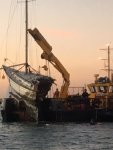FWB
N/A
Just for interest this is a friends Contessa 16.
He bought her new many years ago when she was a 32.
Later modified by Red Funnel. Fortunately he was not aboard at the time. I’ve added a link to the accident report if interested.
I’ve added a link to the accident report if interested.
https://assets.publishing.service.g...ZDDfzCB7VBrkEbDPHRji52cKCICqO_LLZZFlbp9jOCAKc
He bought her new many years ago when she was a 32.
Later modified by Red Funnel. Fortunately he was not aboard at the time.
 I’ve added a link to the accident report if interested.
I’ve added a link to the accident report if interested.https://assets.publishing.service.g...ZDDfzCB7VBrkEbDPHRji52cKCICqO_LLZZFlbp9jOCAKc
Last edited:
